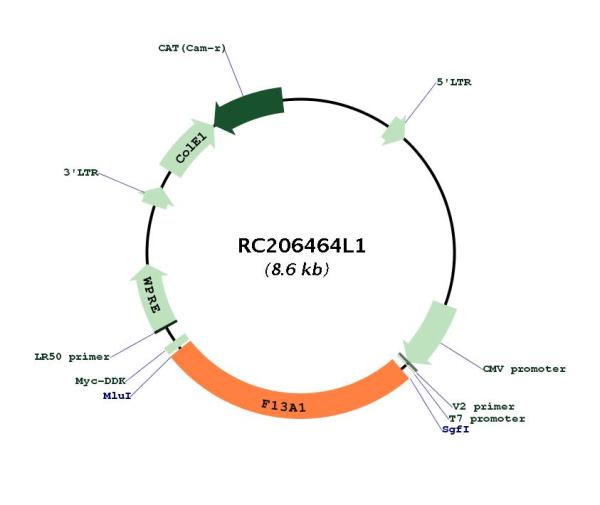Factor XIIIa (F13A1) (NM_000129) Human Tagged Lenti ORF Clone
CAT#: RC206464L1
- LentiORF®
Lenti ORF clone of Human coagulation factor XIII, A1 polypeptide (F13A1), Myc-DDK-tagged
"NM_000129" in other vectors (6)
Specifications
| Product Data | |
| Type | Human Tagged ORF Clone |
| Tag | Myc-DDK |
| Symbol | Factor XIIIa |
| Synonyms | F13A |
| Vector | pLenti-C-Myc-DDK |
| E. coli Selection | Chloramphenicol (34 ug/mL) |
| Mammalian Cell Selection | None |
| Sequence Data |
The ORF insert of this clone is exactly the same as(RC206464).
|
| Restriction Sites |
SgfI-MluI
Cloning Scheme for this gene
Plasmid Map

|
| ACCN | NM_000129 |
| ORF Size | 2196 bp |
| OTI Disclaimer | Due to the inherent nature of this plasmid, standard methods to replicate additional amounts of DNA in E. coli are highly likely to result in mutations and/or rearrangements. Therefore, OriGene does not guarantee the capability to replicate this plasmid DNA. Additional amounts of DNA can be purchased from OriGene with batch-specific, full-sequence verification at a reduced cost. Please contact our customer care team at custsupport@origene.com or by calling 301.340.3188 option 3 for pricing and delivery. The molecular sequence of this clone aligns with the gene accession number as a point of reference only. However, individual transcript sequences of the same gene can differ through naturally occurring variations (e.g. polymorphisms), each with its own valid existence. This clone is substantially in agreement with the reference, but a complete review of all prevailing variants is recommended prior to use. More info |
| OTI Annotation | This clone was engineered to express the complete ORF with an expression tag. Expression varies depending on the nature of the gene. |
| Product Components | The ORF clone is ion-exchange column purified and shipped in a 2D barcoded Matrix tube containing 10ug of transfection-ready, dried plasmid DNA (reconstitute with 100 ul of water). |
| Reconstitution | 1. Centrifuge at 5,000xg for 5min. 2. Carefully open the tube and add 100ul of sterile water to dissolve the DNA. 3. Close the tube and incubate for 10 minutes at room temperature. 4. Briefly vortex the tube and then do a quick spin (less than 5000xg) to concentrate the liquid at the bottom. 5. Store the suspended plasmid at -20°C. The DNA is stable for at least one year from date of shipping when stored at -20°C. |
| Reference Data | |
| RefSeq | NM_000129.3 |
| RefSeq Size | 3863 bp |
| RefSeq ORF | 2199 bp |
| Locus ID | 2162 |
| UniProt ID | P00488 |
| Cytogenetics | 6p25.1 |
| Domains | Transglutamin_C, TGc |
| Protein Families | Druggable Genome, Secreted Protein |
| Protein Pathways | Complement and coagulation cascades |
| MW | 83.3 kDa |
| Gene Summary | This gene encodes the coagulation factor XIII A subunit. Coagulation factor XIII is the last zymogen to become activated in the blood coagulation cascade. Plasma factor XIII is a heterotetramer composed of 2 A subunits and 2 B subunits. The A subunits have catalytic function, and the B subunits do not have enzymatic activity and may serve as plasma carrier molecules. Platelet factor XIII is comprised only of 2 A subunits, which are identical to those of plasma origin. Upon cleavage of the activation peptide by thrombin and in the presence of calcium ion, the plasma factor XIII dissociates its B subunits and yields the same active enzyme, factor XIIIa, as platelet factor XIII. This enzyme acts as a transglutaminase to catalyze the formation of gamma-glutamyl-epsilon-lysine crosslinking between fibrin molecules, thus stabilizing the fibrin clot. It also crosslinks alpha-2-plasmin inhibitor, or fibronectin, to the alpha chains of fibrin. Factor XIII deficiency is classified into two categories: type I deficiency, characterized by the lack of both the A and B subunits; and type II deficiency, characterized by the lack of the A subunit alone. These defects can result in a lifelong bleeding tendency, defective wound healing, and habitual abortion. [provided by RefSeq, Jul 2008] |
Documents
| Product Manuals |
| FAQs |
| SDS |
Resources
Other Versions
| SKU | Description | Size | Price |
|---|---|---|---|
| RC206464 | F13A1 (Myc-DDK-tagged)-Human coagulation factor XIII, A1 polypeptide (F13A1) |
USD 1,005.00 |
|
| RC206464L2 | Lenti ORF clone of Human coagulation factor XIII, A1 polypeptide (F13A1), mGFP tagged |
USD 1,305.00 |
|
| RC206464L3 | Lenti ORF clone of Human coagulation factor XIII, A1 polypeptide (F13A1), Myc-DDK-tagged |
USD 1,305.00 |
|
| RC206464L4 | Lenti ORF clone of Human coagulation factor XIII, A1 polypeptide (F13A1), mGFP tagged |
USD 1,305.00 |
|
| RG206464 | F13A1 (tGFP-tagged) - Human coagulation factor XIII, A1 polypeptide (F13A1) |
USD 1,205.00 |
|
| SC120099 | F13A1 (untagged)-Human coagulation factor XIII, A1 polypeptide (F13A1) |
USD 1,007.00 |
{0} Product Review(s)
Be the first one to submit a review






























































































































































































































































 Germany
Germany
 Japan
Japan
 United Kingdom
United Kingdom
 China
China



